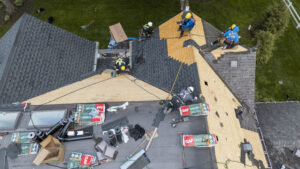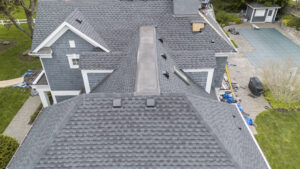As the leaves change and the first chilly winds blow across Ontario, most homeowners focus their winter prep on furnace maintenance and checking window seals. However, if you live in a region that sees heavy snow and deep freezes—which is virtually all of us—the single most critical step you can take to protect your home this season happens in your attic.
We’re talking about ice dams, the damaging, heavy ridges of ice that form along the edges of your roof. They might look charming, but they are a sign of a serious, hidden problem: im – proper attic ventilation.
As a trusted roofing contractor in Ontario serving Hamilton, Mississauga, and the surrounding areas, we know that preventing an ice dam is always cheaper than repairing the damage it causes. Here is your essential guide to understanding the root cause of ice dams and how proper ventilation is your first and best defense.
What is an Ice Dam, and Why is it so Dangerous?
It is important to note that an ice dam is not just a cosmetic winter annoyance—it’s a critical threat to your roofing system and home structure.
The Ice Dam Recipe (How it Forms)
- Heat Loss: Warm air from your living space leaks into your attic; this is usually from poorly sealed light fixtures, chimneys, or inadequate insulation.
- Melt and Flow: This warm air superheats the roof deck, causing the snow on the upper two-thirds of the roof to melt.
- Refreeze: The water flows down the roof until it hits the cold eave- this extends beyond the house’s interior and is not heated from below. Here, it instantly freezes, forming a solid ridge of ice—the dam.
- The Backup: This dam traps water behind it. The pooling, liquid water then works its way backward and uphill underneath your shingles, eventually saturating the roof decking.
The Consequences of the Backup
Unlike a simple roof leak, water from an ice dam given the extremities in Ontario’s weather often backs up deep into your attic, causing a cascade of expensive problems:
- Attic & Ceiling Damage: Soggy insulation, stained ceilings, and paint damage inside the home.
- Structural Rot: Water saturation can lead to mold, mildew, and the rotting of your wooden rafters and fascia boards (a problem we noted in our last post on eavestrough installation).
- Shingle Damage: The constant freeze/thaw cycle and trapped water dramatically reduce the lifespan of your asphalt shingles.
The Solution: A Balanced Ventilation System
The key to preventing an ice dam isn’t just to add more insulation (though that helps); it’s to ensure your attic space is as cold as the outdoors. This is achieved through a properly balanced ventilation system that creates a continuous airflow.
The Ontario Building Code (OBC) mandates minimum standards for attic ventilation, but a truly effective system requires a balance between intake and exhaust.
1. Intake Ventilation: The Eaves (Soffit Vents)
It is important to note that intake vents bring cold, fresh air into the attic; as they are typically located along the eaves, often as continuous soffit vents.
- The Job: Pull the cold, dry air from outside and move it into the lowest part of your attic— therey helping cool the roof decking from underneath before the air can warm up.
- A Crucial Component: Vents must be clear. If your soffit vents are clogged with insulation or dirt, they can’t do their job; thereby being a major ice dam risk.
2. Exhaust Ventilation: The Peak (Ridge Vents)
Exhaust vents allow the slightly warmer, moist air that has moved through the attic to escape- it is important to note that these are actually typically located along the roof’s peak.
- The Job: Here, we want to actually draw hot, damp air out of the attic space, pulling the cooler air from the soffit vents behind it and creating a continuous cooling current.
- Ridge Vents are the most effective exhaust type, running continuously along the entire roof peak for maximum, even airflow.
As experienced professionals in residential roofing and the mandatory soffit and fascia installation that goes with it; at Ontario Tech Roofing, we can inspect your current ventilation system, provide targeted solutions, and ensure your entire roofing assembly is ready to withstand the worst of the Canadian winter.



